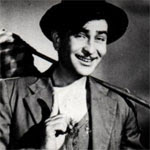 |
| Raj kapoor |
India celebrate 100 years of Indian cinema this year, 2012 is also the centenary year of Bommireddy Nagi Reddy, the veteran filmmaker from South India.
The cinema of India has had a profound effect on cinema across the world since the early 20th century. It consists of films produced across India, which includes the cinematic cultures of Andhra Pradesh, Assam, Bihar, Gujarat, Haryana, Jammu and Kashmir, Karnataka, Kerala, Maharashtra,Orissa, Punjab, Tamil Nadu, Uttar Pradesh and West Bengal. Indian films came to be followed throughout Southern Asia, the Greater Middle East,Southeast Asia, and the former Soviet Union. The cinema as a medium gained popularity in the country as many as 1,000 films in various languages of India were produced annually
Born in Kadapa in Andhra Pradesh on December 2, 1912, Nagi Reddy was a pioneer in the real sense of the term. A doyen of Indian film industry, B Nagi Reddy’s contributions to the society was immense and he touched the heart of the common man in many ways.
Here was a man from a humble background who conquered his dreams despite many trials and tribulations. He broke new ground in whichever industry he laid his hands on. Be it printing, film production, health care and even publishing, Nagi Reddy always led the way and there was no stopping him in all that he ventured into. Wanting to give back to society, he even started Vijaya Hospitals in Chennai, which provides quality health care at a nominal rate.
A hundred years ago Dada Saheb Phalke made a movie about a king who never lied. Phalke’s inspiration came from an English film ‘The Life and Passion of Christ’ and he too wanted to translate the lives of Indian Gods to the screen.
His first production ‘Raja Harishchandra’ was screened at Coronation Cinema in Mumbai on 3 May 1913 marking the beginning of Indian cinema. Regarded as the father of the Indian cinema, Phalke went on to make several silent films but became the first casualty when the silent era passed.
 |
| 100 years Indian cinema |
‘Alam Ara’ debuted at Majestic Cinema in Mumbai on 14 March 1931, a love story between a gypsy and a prince, starring Zubeida, Master Vettal as well as Prithvi Raj Kapoor. It was so popular that police had to be called in to control the crowd. Ironically the first talkie now lies silent as its print perished in a fire in National archive in 2003.
The talkies changed the face of Indian cinema. Apart from looks, the actors not only needed a commanding voice but also singing skills, as music became a defining element in Indian cinema.
In the middle of the Second World War in 1945 came ‘Kismet’ starring Ashok Kumar which became one of the biggest hits in the history of Indian cinema. It came with some bold themes – the first anti-hero and an unmarried pregnancy. It clearly showed that the filmmakers of the era were bolder than the times in which they were living in. By the 1940s, the winning formula at the Box Office had been thought – Songs, dance, drama and fantasy.
 |
| raja-harishchandra 1913 |
A close relationship between epic consciousness and the art of cinema was established. It was against this backdrop that filmmakers like V.Shantaram, Bimal Roy, Raj Kapoor and Mehboob Khan made their films.
In the meantime, the film industry had made rapid strides in the South, where Tamil, Telugu and Kannada films were taking South India by storm. By the late 1940s, films were being made in various Indian languages with religion being the dominant theme.
The golden period of 50’s provided a strong impetus to the industry, with themes changing to social issues relevant at the time. Sure they were entertaining but the movies of that time also became a potent medium to educate the masses. The era established a 25 year actor/filmmaker as the showman of Indian cinema – Raj Kapoor, someone who had an eye for detail.
Recalling the magic of the golden age, Bollywood director Imtiaz Ali says, “The relationship was very tender, very real, and the influences of the contemporary society exhibited in movies of that time is something that I have not seen before.”
 |
| raja-harishchandra 1913 |
Raj Kapoor’s ‘Awara’, the story about a man caught in the centre of a nature Vs nurture debate brought him immense glory. The film went on to become not just a national but international success especially in the then USSR. The film also got nominated in the Cannes film fest in 1943. The actor filmmaker effectively used Chaplin’s character (the one he used in Awara) in later films like ‘Shri 420’. He indianised the chaplin idiom and sat down with the man on the street bringing the spotlight on the common man.
The golden period also produced some of India’s most critically acclaimed films and memorable actors of all time. Among those in Bollywood’s hall of fame are Guru Dutt, Mehboob Khan, Balraj Sahani, Nargis, Bimal Roy, Meena Kumari, Madhubala and Dilip Kumar.
This was the time when mavericks like Guru Dutt and Bimal Roy captivated the audiences with ‘Pyaasa’ and ‘Do Bigha Zamin’, Indian cinema moved one step ahead with K Asif’s magum opus ‘Mughal-e-Azam’ in 1960. It was after the release of this movie that the magnanimity of Indian cinema was established.
 |
| raja-harishchandra 1913 |
Changing social norms and changing economies influenced movies and the companies that made them. This had the effect of changing movies. The narrative style changed. The story structure changed. Characters changed. Content changed.
In the 70’s a genre was born – masala movie. Masala films were the demand of the time. The genre promised instant attraction and had great entertainment value. People flocked to theatre to see their reflection on the big screen. Audiences were enthralled by the histrionics of actors such as Rajesh Khanna, Sanjeev Kumar, Waheeda Rehman, Asha Parekh, Tanuja and others.
While Indian commercial cinema enjoyed popularity among movie-goers, Indian art cinema did not go unnoticed. Adoor Gopalakrishnan, Ritwik Ghatak, Aravindan, Satyajit Ray, Shaji Karun and several other art film directors were making movies that gave India international fame and glory.
This was Bollywood’s prime period, a time when director Ramesh Sippy gave us his iconoclastic ‘Sholay’ (1975). The film, which has been internationally acclaimed, also clinched the title of ‘superstar’ for Amitabh Bachchan, who already had over 30 films under his belt by then.
80’s saw the emergence of several woman directors such as Aparna Sen, Prema Karnath and Meera Nair. It was also the decade when sultry siren Rekha wooed audiences with her stunning performance in ‘Umrao Jaan’ (1981).
And then in 90’s, it was a mixed genre of romantic, thrillers, action and comedy films. A stark upgrade can be seen on the canvas as technology gifted the industry Dolby digital sound effects, advanced special effects, choreography and international appeal. The development brought about investments from the corporate sector along with finer scripts and performances.
It was time to shift focus to aesthetic appeal. And stars like Shah Rukh Khan, Rajnikanth, Madhuri Dixit, Aamir Khan, Chiranjeevi, Juhi Chawla and Hrithik Roshan began to explore ways to use new techniques to enrich Indian cinema with their performances.
Indian cinema finally found global mass appeal at the turn of the 21st century. As the world became a global village, the industry reached out further to international audiences.
Apart from regular screenings at major international film festivals, the overseas market contributed a sizeable chunk to Bollywood’s box office collections.
Regular foreign Investments made by major global studios such as 20th Century Fox, Sony Pictures, and Warner Bros put a stamp of confirmation that Bollywood had etched itself on the global podium.

















No comments:
Post a Comment